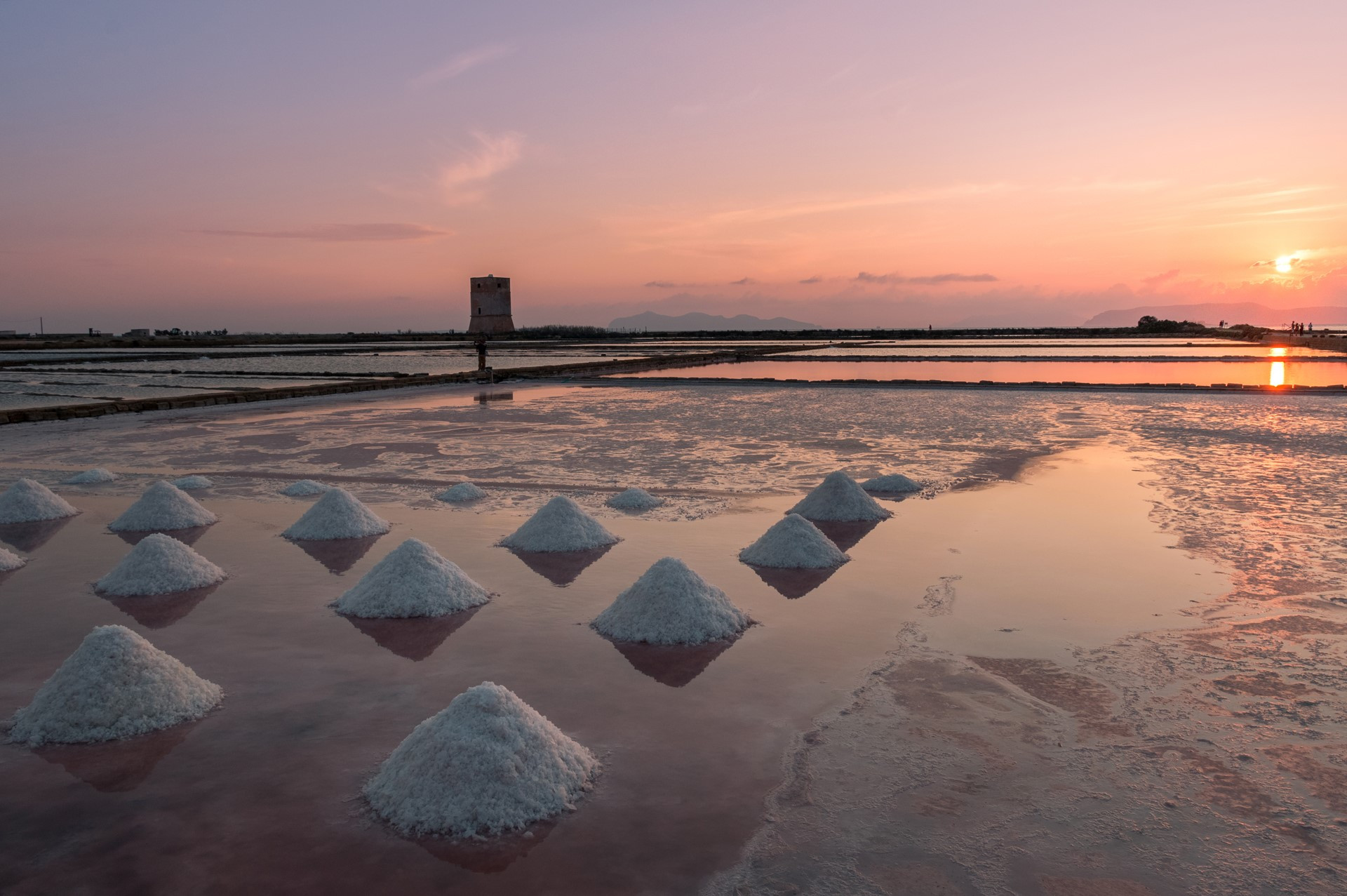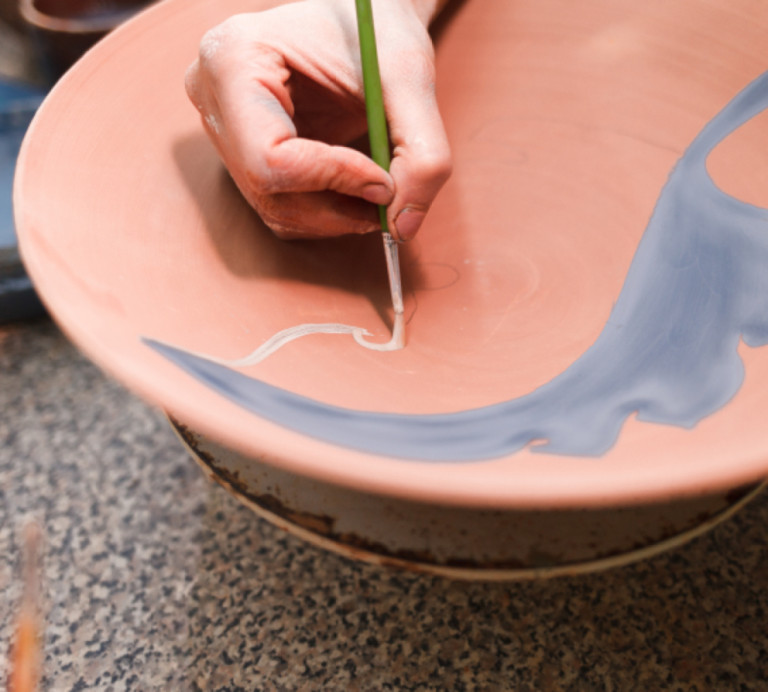
What to see in Trapani
Staying at Bassi 77 Rooms & Apartments, you'll have the opportunity to explore the history and beauties of Trapani thanks to the advice from Sandra and Francesco and the excellent location of the property: the B&B is indeed located adjacent to the bustling Via Fardella, known for shopping, and just a stone's throw from the beach of Trapani and the historic center.
Famous worldwide for its corals, tuna fishing, salt pans, and windmills, Trapani today is an ideal tourist destination for those who want to enjoy a relaxing vacation amidst the most beautiful beaches of the western coast and the crystal-clear sea of the Egadi Islands, but also for those who want to discover unique traditions, places, and cultural assets, as well as taste the authentic flavors of Trapanese and Sicilian cuisine.
Here's a brief checklist of things to do and see in Trapani:
- The historic center
- The salt pans of Trapani and those of Marsala
- The Mysteries of Trapani
- The Pepoli museum
- Relax on the beaches of Trapani and its surroundings
- Erice
- Segesta and Selinunte
- The Egadi Islands
- What to eat in Trapani
- Nightlife and entertainment in Trapani
1.The historic center of Trapani: what to see
The visit to the city of Trapani can only start from its historic center, a place to discover the beautiful architectural testimonies of the past and get in touch with its oldest traditions.
Characterized by a pavement in cobblestones, the historic center of Trapani winds through shops, restaurants, pubs, noble palaces, and ancient city gates, such as the Porta Oscura of the Clock Tower, where you can admire one of the oldest astronomical clocks in Europe.
The historic center of Trapani is structured around 3 main streets: Via Garibaldi, Via Torrearsa, and Corso Vittorio Emanuele, streets of major attraction not only for tourists but also for the Trapanese themselves.
Walking along Corso Vittorio Emanuele, you can admire the Senatorial Palace or Cavarretta Palace, a baroque spectacle adorned with statues, currently the seat of the city council.
Continuing along Corso Vittorio Emanuele, you reach the Piazza dell'ex Mercato del Pesce, in this square, Via delle Mura di Tramontana opens up, a stretch of walls that represented the very border of the city and aimed to protect Trapani from pirates and invaders who sought to conquer the city as a strategic port operation.
We recommend walking along the Mura di Tramontana at sunset to experience one of the most fascinating scenes of Trapani, appreciated by both locals and visitors.
Trapani is rich in churches, hence its nickname "the city of 100 churches." Among these, in the center, stand out: the Baroque Church of the Holy Souls of Purgatory where the Sacred Groups of the Mysteries are kept; the Cathedral of San Lorenzo, with its sumptuous baroque facade dating back to the Norman era; the church of Sant'Agostino, one of the oldest in Trapani, located in Piazza Saturno, and the church of San Pietro, which houses one of the most complex and spectacular organs in the world.
Continuing the walk along the walls of Tramontana, you will reach one of the symbols of Trapani: the Tower of Ligny, an ancient seventeenth-century fortress that defended Trapani from the raids of enemy ships for centuries. Located on the extreme tip of Sicily where the two seas, the Mediterranean Sea and the Tyrrhenian Sea, meet, this place offers a splendid panorama of the Egadi Islands on one side and Mount Erice on the other.
Currently, the Tower of Ligny houses the Civic Anthropological Museum, which hosts an archaeological collection including helmets and weapons from the Punic Wars, as well as amphorae and anchors from Greek ships, in addition to prehistoric tools.
From the Tower of Ligny, you can reach the fish market and the fishing port of Trapani, which is the best way to immerse yourself in the atmosphere and maritime culture of this city. The daily catch boxes, the cheerful and busy chatter of the fishermen, the colorful fishing boats, and the beautiful Madonna of the Port create a typical and evocative scene. We also recommend stopping at one of the bars in the area to enjoy the spectacle while sipping a Sicilian granita or a spritz!
The center of Trapani is also the evening meeting place for young and old alike. Here, in fact, there are many restaurants, ice cream parlors, pizzerias, breweries, and cocktail bars.
2. The salt pans of Trapani and Marsala
The city of Trapani is famous for the production of sea salt, a high-quality salt produced exclusively in the salt pans of Trapani, Paceco, and Marsala, which has obtained the recognition of PGI (Protected Geographical Indication) and the denomination of "Sale Marino di Trapani" (Trapani Sea Salt).
The salt pans of Trapani are just a 7-minute drive from Bassi 77, or if you prefer cycling, you can reach them in about 15 minutes.
Taking a walk among the salt pans of Trapani is a beautiful experience that we recommend, especially at sunset, when land, sea, and sky seem to merge, creating wonderful plays of color. Here, you can also visit the Salt Museum of Nubia and learn about the salt production process and the ancient working tools that the "salt workers" used to collect and process the salt.
Don't miss the Ettore and Infersa salt pans in Marsala either. Here, you can experience true cultural, sensory, and gastronomic experiences ranging from the evocative aperitif on the Long Island (reachable by boat or on foot), to the wellness path immersed in the salt pans, to the opportunity to take up the tools of the trade and participate in salt harvesting alongside the salt workers.
3. The Mysteries of Trapani
If you visit Trapani during the Easter holidays, you will have the opportunity to witness the historic and moving Procession of the Mysteries, the most anticipated event of the year for the people of Trapani, which takes place every year, for over 400 years, on Good Friday preceding Easter.
This ancient tradition, which attracts thousands of faithful, devotees, and tourists every year, stages the passion and death of Christ through the streets of the city center, where, for 24 hours, 18 sculptural groups and two effigies are paraded on the shoulders of volunteers and devotees, the so-called "massari." Each sacred group is accompanied by a group of faithful from different social classes and by a band that plays funeral marches along the route.
Traditionally, the Procession of the Mysteries of Trapani begins at 2:00 PM on Good Friday, when the Sacred Groups make their solemn exit from the Church of the Purgatory, and ends the next day, Saturday at 2:00 PM, with the return of the Sacred Groups to the same church.
4. The Pepoli Museum
Among the things to see in Trapani is certainly the Agostino Pepoli Regional Museum, located inside the convent of the Carmelite Fathers. The structure, dating back to 1315, is adjacent to the Sanctuary of the Santissima Annunziata, which houses the statue of the "Madonna of Trapani," to which the people of Trapani are particularly devoted.
Inside the Pepoli Museum, you can admire a vast collection of coral works and jewelry, including the Treasure of the Madonna of Trapani; paintings and applied arts; majolica, archaeological finds, and Renaissance sculptures.
Opening hours and ticket cost for the Pepoli Museum:
Opening hours:
Tuesday to Saturday, from 9:00 AM to 6:00 PM (last entry at 5:00 PM)
Sunday and holidays, from 9:00 AM to 1:00 PM (last entry at 12:00 PM)
Ticket cost: €6
Ticket reservation here: http://laculturariparte.youline.cloud/
5. The most beautiful beaches in Trapani
San Giuliano Beach - Erice
The Trapani area is famous for its crystal-clear sea and its fine sandy beaches.
Trapani has several beaches located in the city center. One of the most famous is San Giuliano Beach, located just a few minutes from the city's historic center and just a 5-minute drive from Bassi 77.
San Giuliano Beach extends for about two kilometers and is characterized by very light colors, fine white sand, and transparent, clear sea. About half of the beach is free access, while the rest is dotted with bathing establishments offering various services such as sunbed and umbrella rental, bars, and restaurants.
Torre di Ligny Beach
In the historic center, we find Torre di Ligny Beach, one of the most picturesque places in Trapani. It is a small beach mainly made up of rocks from which you can admire the Egadi Islands on one side and the profile of Mount Erice on the other.
Mura di Tramontana Beach – Porta Ossuna
Also in the historic center, you can take a relaxing break at Mura di Tramontana Beach, under the mighty medieval walls of ancient Trapani. Here, the sand is fine and golden, and the shallow depth of the sea at the shore makes the beach a safe destination, especially for families with children.
Piazza Vittorio Emanuele II Beach
Another beach very close to the historic center is the beach located in front of the homonymous Piazza Vittorio Emanuele. It is a free access beach, ideal for those who want to enjoy a swim without moving away from the beauties of the historic center, also recommended for families with children due to the shallow water depth.
San Vito Lo Capo Beach
If you are in Trapani, you cannot miss San Vito Lo Capo! Famous for its crystal-clear waters and white sand, it is like diving into a small paradise. Its waters are suitable for swimming as well as for all water sports activities.
With its typical restaurants and trendy bars, San Vito Lo Capo is the ideal place for an unforgettable beach vacation, even with the little ones!
Zingaro Nature Reserve
For nature lovers, a visit to the Zingaro Nature Reserve in the province of Trapani is a must! The Zingaro Reserve offers a colorful coastal landscape with enchanting coves overlooking wonderful turquoise waters. There are also numerous marine caves, secluded coves, and cliffs that offer absolutely breathtaking natural scenery. Moreover, you can do many activities within the reserve, such as hiking, birdwatching, or snorkeling to admire the rich underwater life.
Scopello
If you are looking for a dream beach, you cannot miss the picturesque cliffs of Scopello. This spectacular landscape is surrounded by beautiful crystal-clear waters and fascinating caves that offer a unique experience for sea lovers.
Pizzolungo
Just 8 km from Trapani is Pizzolungo: a charming seaside resort known for its splendid crystal-clear sea with a backdrop of high rocky cliffs and countless natural caves.
Cornino and the Monte Cofano Reserve
Continuing from Pizzolungo for about 14 km, you will arrive at Cornino, a small resort less chaotic than other tourist destinations but with truly spectacular sea. The beach is made up of small grains of sand and rocks, the water is rather cold but very clean, and the seabed is ideal for snorkeling.
For the more adventurous, we recommend visiting the Monte Cofano Reserve, a protected area of the province of Trapani that extends into the municipalities of Custonaci and San Vito Lo Capo and has the symbolic mountain of Monte Cofano. A paradise for hiking and outdoor vacations enthusiasts!
6. Erice
Located 15 km from Trapani and easily accessible by car or cable car, Erice is one of the most beautiful villages in Italy. Built on the homonymous mountain at 750 meters above sea level, Erice offers a breathtaking panorama of the Sicilian coast and will immerse you in the past with its cobblestone streets, stone houses, churches with baroque facades, and small courtyards.
Among the things to see in Erice, do not miss the Mother Church, Piazza Garibaldi, the Castle of Venus, and the Pepoli Castle. And, of course, you cannot leave without first tasting the famous Genovesi Ericine and the traditional almond paste sweets.
A Dive into History: The Temple of Segesta and the Greek Theater
About 30 km from Trapani lies the Archaeological Park of Segesta, one of the largest archaeological areas in Europe, which includes 12 sites to visit, including the Doric Temple and the Temple of Segesta.
The latter, built between 430 and 420 B.C., is considered one of the most fascinating and mysterious temples of Magna Graecia. Never completed and remaining intact for millennia, it is truly majestic, consisting of 36 columns over 10 meters high.
Also within the Segesta Park, atop Monte Barbaro, is the Greek Theater of Segesta, considered one of the most beautiful theaters of the classical period. During the summer, this ancient theater becomes the setting for important musical concerts and national and international performances.
8. The Egadi Islands: Breathtaking Landscapes and Dreamy Sea
With breathtaking natural landscapes and wonderful turquoise waters, the Egadi Islands are a true paradise! The Egadi Islands – Favignana, Levanzo, and Marettimo – are an archipelago located within the province of Trapani, easily reachable by ferry or hydrofoil departing from the port of Trapani.
Favignana, the largest of the three, shows off its natural and wild beauty with pristine coves and lush waters.
Marettimo, on the other hand, is the wildest and most unspoiled. Among crystal-clear waters to be discovered almost exclusively by boat, peaks to conquer, and forests to explore, you will be enchanted!
Levanzo, the smallest of the Egadi but the most romantic: among its pristine blue depths, its caves, and its characteristic beaches, you will truly feel like you are on the island that does not exist!
Have you planned your vacation in Trapani and can't wait to visit these wonderful islands? You can easily reach them by hydrofoil or ferry departing from the port of Trapani.
Bassi 77 B&B is very close to the port of Trapani: you can reach it in just 6 minutes by bike, in 20 minutes on foot, or in 5 minutes by car. Once you reach the port, it will only take you 30 minutes by hydrofoil to dive into the azure waters of Favignana, Levanzo, and Marettimo!
9.What to Eat in Trapani
The cuisine of Trapani, born from the blending of diverse peoples and cultures, is characterized by the high quality and variety of the raw materials used.
The territory of Trapani offers an extraordinary quantity of excellent agri-food products such as: red garlic from Nubia, Pantelleria IGP capers, Trapani IGP sea salt, Valli Trapanesi DOP extra virgin olive oil, Vastedda from the Belìce Valley DOP, and black bread from Castelvetrano. There are also wines with Controlled Designation of Origin such as the famous Marsala wine, the white wine from Alcamo, and the sweet Moscato DOC from Pantelleria.
One of the most famous dishes is Trapanese Cous Cous, an Arab-origin dish made from semolina soaked in fish broth and seasoned with fish, although there are variants with meat and vegetables. The traditional preparation is long and laborious and requires a certain skill, especially in the so-called "incocciatura."
Another specialty of Trapani is busiate, a type of fresh pasta usually served with fish or with the famous pesto alla trapanese, also called pasta with garlic: a pesto made from garlic, tomato, almonds, and basil, strictly accompanied with fried eggplants and/or fried potatoes!
The undisputed star of the table is fish, especially tuna, called "sea pork" because, like land pork, nothing goes to waste, and from it, excellent tuna products are obtained such as: "ficazza" obtained from the dorsal parts of the tuna; lattume, obtained from the seminal fluid sac of the male tuna; bottarga, obtained from tuna eggs; and tuna "mosciame," obtained from the preparation of the lean fillet of yellowfin tuna.
Another fishery excellence of the territory is the Red Prawn of Mazara del Vallo, one of the most prized crustaceans in the world. Characterized by a bright red color, almost reminiscent of coral, and a strong and unmistakable flavor, with slightly sweet notes. A real delicacy to be enjoyed both cooked and raw.
Other typical dishes of Trapanese cuisine include rice arancine (yes, here they are called arancine, in the feminine, and not arancini!); panelle; "cunzato" bread, i.e., bread soaked in oil and seasoned with oregano, tomato, fresh cheese, and salted anchovies; caponata; Trapanese pizza, in particular, "rianata"; pasta with fresh sardines, pasta in lobster broth, and spaghetti with tuna bottarga.
Among the sweet specialties, you cannot miss the famous cannoli, Sicilian cassata, granita, and Genovesi ericine, delicious shortcrust pastry sweets filled with delicate custard.
In short, Trapanese cuisine offers a wide choice, so you just have to try it! Bassi 77 will be happy to recommend the best restaurants to eat in Trapani and the main specialties to taste.
10. Nightlife in Trapani
The nightlife of Trapani is truly lively and bustling, especially in summer. Restaurants, trendy taverns, wine bars, and cocktail bars are concentrated in the port and historic center area. Here you can taste traditional Trapanese dishes, enjoy a sunset aperitif with a sea view, or spend a fun after-dinner in one of the many venues that offer musical entertainment and DJ sets during the summer.




